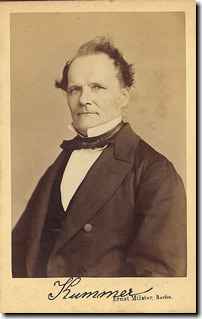Ernst Kummer facts for kids
Quick facts for kids
Ernst Kummer
|
|
|---|---|
 |
|
| Born |
Ernst Eduard Kummer
29 January 1810 Sorau, Prussia
|
| Died | 14 May 1893 (aged 83) Berlin, Brandenburg, Germany
|
| Nationality | Prussian |
| Alma mater | University of Halle (Ph.D., 1831) |
| Known for | Bessel functions, Kummer theory, Kummer surface, and other contributions |
| Scientific career | |
| Fields | Mathematics |
| Institutions | University of Berlin University of Breslau Gewerbeinstitut Lomonosov University |
| Thesis | De cosinuum et sinuum potestatibus secundum cosinus et sinus arcuum multiplicium evolvendis (1831/1832) |
| Doctoral advisor | Heinrich Scherk |
| Doctoral students | Gotthold Eisenstein Georg Frobenius Lazarus Fuchs Wilhelm Killing Adolf Kneser Franz Mertens Hermann Schwarz Georg Cantor Hans Carl Friedrich von Mangoldt Adolf Piltz Friedrich Prym |
Ernst Eduard Kummer (born January 29, 1810 – died May 14, 1893) was an important German mathematician. He was very good at using math to solve real-world problems, which is called applied mathematics. Kummer even taught German army officers about ballistics, which is the science of how bullets and rockets fly.
Later, he spent 10 years teaching at a gymnasium. This was like a German high school. While teaching there, he inspired another famous mathematician, Leopold Kronecker, to pursue a career in math.
Life of Ernst Kummer
Ernst Kummer was born in a town called Sorau. At that time, Sorau was part of Prussia. He studied at the University of Halle. In 1831, he earned his PhD. He received this degree for writing a winning essay on a math topic. This essay was published a year later.
In 1840, Kummer married Ottilie Mendelssohn. Her father was Nathan Mendelssohn. Ottilie was also a cousin of the famous composer Felix Mendelssohn. She was also related to Rebecca Mendelssohn Bartholdy, who was married to another mathematician, Peter Gustav Lejeune Dirichlet.
After Ottilie passed away in 1848, Kummer married her maternal cousin, Bertha Cauer. Ernst Kummer had 13 children in total. One of his daughters, Marie, also married a mathematician named Hermann Schwarz. Kummer stopped teaching and retired from mathematics in 1890. He died three years later in Berlin.
Kummer's Contributions to Mathematics
Kummer made many important discoveries in different areas of mathematics. He helped organize some relationships between different hypergeometric series. These are special types of mathematical series.
He also studied something called the Kummer surface. This is a complex shape in geometry. It has 16 special points and was studied a lot in the 1800s.
Kummer also worked on a very famous math problem called Fermat's Last Theorem. This theorem states that no three positive integers a, b, and c can satisfy the equation aⁿ + bⁿ = cⁿ for any integer value of n greater than 2. Kummer was able to prove this theorem for many types of prime exponents. He used methods that were similar to what we now call p-adic numbers. He also helped develop the idea of "ideal numbers," which are important in a part of math called number theory.
Kummer also looked into Kummer extensions. These are ways to create new number fields by adding special roots to existing ones. This work was very important for understanding class field theory, which is a major part of advanced number theory.
Beyond pure math, Kummer also researched ballistics. This is the science of how projectiles, like bullets, move through the air. He also worked with another scientist, William Rowan Hamilton, to study ray systems.
See also
- Kummer configuration
- Kummer's congruence
- Kummer series
- Kummer theory
- Kummer's theorem, on prime-power divisors of binomial coefficients
- Kummer's function
- Kummer sum
- Kummer variety
- Kummer–Vandiver conjecture
- Kummer's transformation of series
- Ideal number
- Regular prime
- Reflection theorem
- Principalization
- 25628 Kummer – asteroid named after Ernst Kummer
 In Spanish: Ernst Kummer para niños
In Spanish: Ernst Kummer para niños

